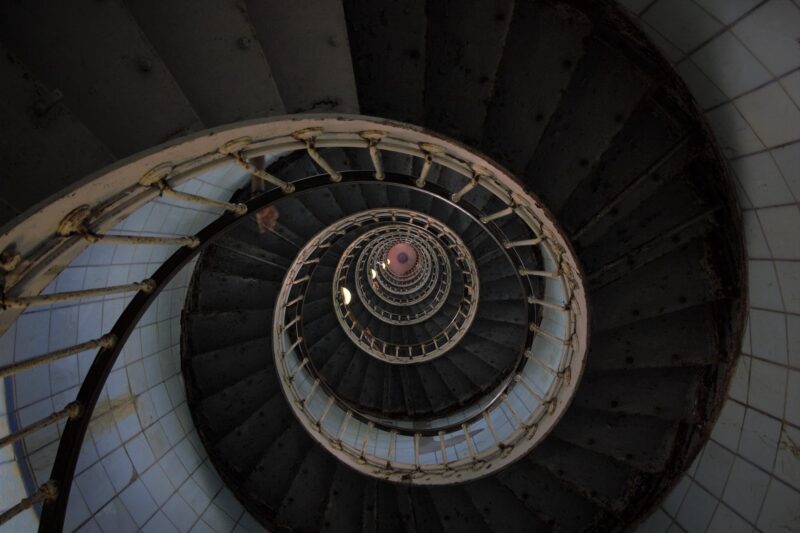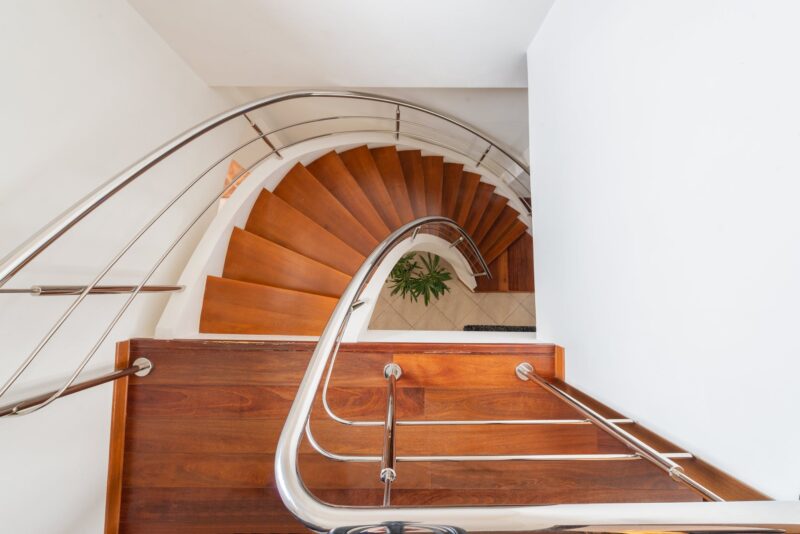Are you looking to add a touch of elegance and functionality to your home? Building a spiral staircase might be just the project for you! While it may seem like a complex task, with the right guidance and a bit of patience, you can create a stunning spiral staircase that will become the centrepiece of your home. In this guide, we will walk you through the process of building a spiral staircase in 15 easy steps.
Step 1: Plan and Design

Before you begin construction, it’s important to plan and design your spiral staircase. Consider the available space, the desired height, and the materials you want to use. Sketch out your design and take accurate measurements to ensure a smooth building process.
Here are some steps to help you plan and design your spiral staircase:
- Step 1: Choose a location for your spiral staircase. You will need an unused corner or open area that is not too high or too low, and that has enough space for the diameter of your staircase. You will also need to consider the direction of the spiral, the height difference between the floors, and the safety requirements of your local building codes.
- Step 2: Measure the dimensions of your staircase. You will need to know the total height of your staircase from floor to floor, the diameter of your staircase at its widest point, and the width of each step. You can use a tape measure or a laser level to measure these distances accurately.
- Step 3: Design the layout of your staircase. You will need to decide how many steps you want in your spiral, how wide each step should be (at least 26 inches), how deep each step should be (at least 7-1/2 inches), how high each step should be (at least 12 inches from its narrow end), how long each step should be (at least 7 feet), how far apart each step should be (at least 6 feet), how much clearance you need for turning around (at least 6 feet), how much headroom you need for walking up and down (at least 6 feet 6 inches), and where you want to place your handrail (34 to 36 inches above each step nose).
- Step 4: Draw a sketch of your staircase plan on paper or use a software program to create a digital model. You can use graph paper or an online tool like [Spiral Staircase Calculator] to help you with this step. Make sure that your plan shows all the details of your staircase design, such as the number and size of steps, the angle and direction of rotation, the position and length of handrail balusters, and any other features you want to include.
- Step 5: Gather your materials and tools for building your spiral staircase. You will need some basic materials like wood planks or plywood sheets for making treads (steps) and risers (vertical parts between steps), metal pipes or rods for making centre column support brackets, screws or bolts for joining materials together, nails or glue for fastening materials together, wood blocks or wedges for adjusting treads if needed, wood shims or spacers for levelling treads if needed, wood glue or epoxy resin for bonding materials together, sandpaper or files for smoothing surfaces if needed, paint or stain for finishing surfaces if desired.
Step 2: Gather Materials
Next, gather all the necessary materials for your project. This may include wood or metal for the steps, a central column, handrails, and any additional decorative elements you desire. Make sure you have all the tools you need as well, such as a drill, saw, and measuring tape.
Step 3: Prepare the Base
Start by preparing the base for your spiral staircase. This may involve removing any existing flooring or creating a solid foundation if needed. Ensure that the base is level and secure before proceeding.
Related:
Step 4: Install the Central Column
Next, install the central column that will support the steps of your spiral staircase. Use a level to ensure it is perfectly vertical and secure it to the base. This column will serve as the backbone of your staircase.
Step 5: Attach the Steps
Now it’s time to attach the steps to the central column. Depending on the material you choose, you may need to cut and shape each step to fit perfectly. Attach them securely, making sure they are level and evenly spaced.
Step 6: Install the Handrail

For safety and aesthetics, install a handrail along your spiral staircase. This can be made from wood, metal, or a combination of both. Ensure it is securely attached to the central column and meets local building codes.
Step 7: Add Decorative Elements
If desired, add decorative elements to enhance the visual appeal of your spiral staircase. This could include ornamental balusters, finials, or decorative trim. Get creative and make your staircase truly unique.
Step 8: Sand and Finish
Once the construction is complete, sand down any rough edges and apply a finish to protect the wood or metal. This will also give your spiral staircase a polished look.
Step 9: Paint or Stain
If you prefer a different colour or want to match your existing decor, paint or stain your spiral staircase. Choose a high-quality paint or stain that will withstand regular use and add a personal touch to your creation.
Step 10: Install Lighting
To showcase your spiral staircase, consider installing lighting along the steps or under the handrail. This will not only provide functional illumination but also create a stunning visual effect.
Step 11: Test for Safety
Before you start using your new spiral staircase, test it for safety. Ensure that each step is secure, the handrail is sturdy, and there are no sharp edges or protrusions that could cause injury.
Step 12: Enjoy Your Creation
Congratulations! You have successfully built a spiral staircase. Take a moment to admire your hard work and enjoy the beauty and functionality it brings to your home.
Step 13: Maintain Regularly
To keep your spiral staircase in top condition, perform regular maintenance. Clean it regularly, tighten any loose screws or bolts, and inspect for any signs of wear or damage.
Step 14: Seek Professional Help if Needed
If at any point during the construction process, you feel overwhelmed or unsure, don’t hesitate to seek professional help. A skilled contractor or carpenter can provide guidance and ensure your spiral staircase is built to the highest standards.
Step 15: Inspire Others
Share your experience and inspire others by showcasing your spiral staircase. Whether it’s through social media, home improvement forums, or inviting friends and family over, let others see the beauty and craftsmanship of your creation.
Conclusion
Building a spiral staircase may seem like a daunting task, but with the right guidance and a bit of creativity, you can create a stunning architectural feature in your home. Follow these 15 easy steps, and soon you’ll be enjoying the beauty and functionality of your very own spiral staircase. Happy building!
Frequently Asked Question
A spiral staircase can save space, add aesthetic appeal, and increase the value of your home. It can also fit in tight corners or open areas where a conventional staircase might not be suitable.
A spiral staircase consists of a centre column, treads, handrail, balusters, and platform. The treads are the steps that spiral around the column. The handrail is the railing that runs along the outer edge of the treads. The balusters are the vertical posts that support the handrail. The platform is the landing area at the top of the staircase.
You need to measure the height and diameter of your staircase, as well as the size and shape of each tread. You can use a spiral staircase calculator online to help you with the design. You also need to check your local building codes and regulations to make sure your staircase meets the safety standards.
Depending on the type of staircase you want, you may need different materials and tools. For example, if you want a wooden staircase, you may need wood boards, screws, nails, a drill, a saw, a hammer, a level, a tape measure, etc. If you want a metal staircase, you may need metal rods, welding tools, grinders, etc. You can also buy a spiral staircase kit that includes all the parts and instructions you need.
The installation process may vary depending on the staircase kit or design you choose. Generally, you need to assemble the column section, install the base plate, slide the treads onto the column, attach the platform, secure the column to the floor, attach the balusters, install the handrail, and add any decorative elements.












1 comment
Іt’s nearⅼy impossible to fіnd experienced people
about this subject, but you sound like you know what
you’re talking about! Thanks